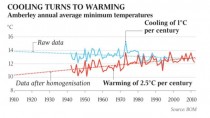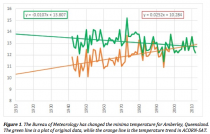The [Australian] Bureau of Meteorology has been accused of manipulating historic temperature records to fit a predetermined view of global warming. Researcher Jennifer Marohasy claims the adjusted records resemble “propaganda” rather than science. Dr Marohasy has analyzed the raw data from dozens of locations across Australia and matched it against the new data used by BOM showing that temperatures were progressively warming. In many cases, Dr Marohasy said, temperature trends had changed from slight cooling to dramatic warming over 100 years. Graham Lloyd, The Australian, 23 August 2014
The escalating row goes to heart of the climate change debate - in particular, whether computer models are better than real data and whether temperature records are being manipulated in a bid to make each year hotter than the last. Marohasy’s research has put her in dispute with BoM over a paper she published with John Abbot at Central Queensland University in the journal Atmospheric Research concerning the best data to use for rainfall forecasting. BoM challenged the findings of the Marohasy-Abbot paper, but the international journal rejected the BoM rebuttal, which had been prepared by some of the bureau’s top scientists. This has led to an escalating dispute over the way in which Australia’s historical temperature records are “improved” through homogenization, which is proving more difficult to resolve. Graham Lloyd, The Australian, 23 August 2014
When I first sent Graham Lloyd some examples of the remodeling of the temperature series I think he may have been somewhat skeptical. I know he on-forwarded this information to the Bureau for comment, including three charts showing the homogenization of the minimum temperature series for Amberley. Mr Lloyd is the Environment Editor for The Australian newspaper and he may have been concerned I got the numbers wrong. He sought comment and clarification from the Bureau. I understand that by way of response to Mr Lloyd, the Bureau has not disputed these calculations. What the Bureau has done, however, is try and justify the changes. In particular, for Amberley the Bureau is claiming to Mr Lloyd that there is very little available documentation for Amberley before 1990 and that information before this time may be “classified”: as in top secret. - Jennifer Marohasy, 23 August 2014
Congratulations to The Australian again for taking the hard road and reporting controversial, hot, documented problems, that few in the Australian media dare to investigate.
How accurate are our national climate datasets when some adjustments turn entire long stable records from cooling trends to warming ones (or visa versa)? Do the headlines of “hottest ever record” (reported to a tenth of a degree) mean much if thermometer data sometimes needs to be dramatically changed 60 years after being recorded?
One of the most extreme examples is a thermometer station in Amberley, Queensland where a cooling trend in minima of 1C per century has been homogenized and become a warming trend of 2.5C per century. This is a station at an airforce base that has no recorded move since 1941, nor had a change in instrumentation. It is a well-maintained site near a perimeter fence, yet the homogenization process produces a remarkable transformation of the original records, and rather begs the question of how accurately we know Australian trends at all when the thermometers are seemingly so bad at recording the real temperature of an area. Ken Stewart was the first to notice this anomaly and many others when he compared the raw data to the new, adjusted ACORN data set. Jennifer Marohasy picked it up, and investigated it and 30 or so other stations. In Rutherglen in Victoria, a cooling trend of -0.35C became a warming trend of +1.73C. She raised her concerns (repeatedly) with Minister Greg Hunt.
Now the Australian Bureau of Meteorology has been forced to try to explain the large adjustments. Australians may finally gain a better understanding of what “record” temperatures mean, and the certainty ascribed to national trends. There is both a feature and a news piece today in The Weekend Australian. Jo Nova The heat is on. Bureau of Meteorology ‘altering climate figures’ The Australian
Bob Tisdale, WUWT
It never fails. Hurricanes and tropical cyclones always bring out the manmade global warming alarmists, with their claims of unusually warm sea surface temperatures along the storm tracks. Of course those fictionally warmed sea surface temperatures were caused by rising CO2 emissions. We expected and saw that nonsense when Sandy struck the east coast of the U.S. mainland back in 2012. Not unexpectedly, data contradicted the claims. See the posts here and here.
The same unwarranted alarmist claims magically appeared when the two tropical cyclones (Iselle and Julio) threatened Hawaii last week. Iselle’s storm track is shown on the map to the right. (Please click on it to enlarge.) I’ve highlighted the coordinates I’ve used for Iselle’s storm track...before it reached Hawaii. Julio’s track was similar but ran a little north of Iselle’s. So, were the sea surface temperatures along Iselle and Julio’s storm tracks unusually warm, and have the sea surface temperatures there warmed during the satellite era?
WEEKLY DATA
The weekly Reynolds OI.v2 sea surface temperature anomalies for the coordinates of 15N-20N, 155W-120W, for the week centered on August 6, 2014, were above the 1971-2000 average. (Those are the base years used by NOAA for the Reynolds OI.v2 data.) But they were not unusually warm as shown by the horizontal red line. They have been warmer quite regularly since the start of the weekly data in January 1990. And it’s blatantly obvious that the sea surface temperatures have cooled there. The cooling rate is -0.3 deg C/decade since 1990, based on the linear trend shown in blue.
Weekly Hawaii Storm Track SSTa
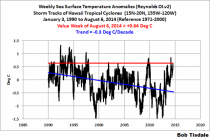
Enlarged
Weekly Iselle and Julio Storm Track SST Anomalies
MONTHLY DATA
The monthly satellite-enhanced Reynolds OI.v2 data stretches back as far as November 1981. The July 2014 sea surface temperature anomalies for Iselle and Julio’s storm tracks (shown in red) were not unusually warm, and the sea surface temperatures there have cooled since November 1981 based on the linear trend (shown in blue).
Monthly Hawaii Storm Track SSTa

Enlarged
Monthly Iselle and Julio Storm Track SST Anomalies
HOW FAR BACK CAN WE GO AND STILL SHOW NO WARMING IN THAT PART OF THE EASTERN TROPICAL NORTH PACIFIC?
The next graph shows the NOAA ERSST.v3b-based sea surface temperature anomalies for the coordinates of 15N-20N, 155W-120W, from January 1880 to July 2014. I’ve highlighted the period of January 1930 through July 2014 in brown. Since January 1930, the warming rate of the sea surface temperatures for Iselle and Julio’s storm track is only +0.004 deg C/decade. That’s 4 one-thousandths of a degree C per decade. And as shown by the red horizontal line, the sea surface temperature anomalies back as far as the 1880s were comparable the July 2014 value...if you believe sea surface temperature data back that far.
Long Term Monthly Hawaii Storm Track SSTA
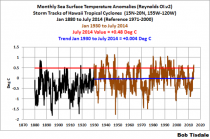
Enlarged
Long-Term Monthly Iselle and Julio Storm Track SST Anomalies
YEAH BUT, YEAH BUT, YEAH BUT
History has shown, if I were to end the post there, then someone would say something to the effect of, Greenhouse gases have increased the amount of moisture in the air, making tropical storms worse than before.
To counter that nonsense, we turn to the NCEP/DOE Reanalysis-2 outputs of Specific Humidity, which represents the amount of moisture in the column of atmosphere. The units are kilogram of water vapor/kilogram of dry air. For Iselle and Julio’s storm tracks, there is nothing unusual high in the specific humidity for July 2014, and the trend since 1979 shows a decrease, not increase, in specific humidity southeast of Hawaii.
Monthly Hawaii Storm Track Specific Humidity
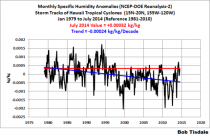
Enlarged
Monthly Iselle and Julio Storm Track Specific Humidity Anomalies
SOURCES
The weekly and monthly Reynolds OI.v2 sea surface temperature data are available through the NOAA NOMADS website here. The long-term monthly NOAA ERSST.v3b sea surface temperature data are available through the KNMI Climate Explorer. And the monthly specific humidity output of the NCEP-DOE Reanalysis-2 is available from the NOAA NOMADS website here.



